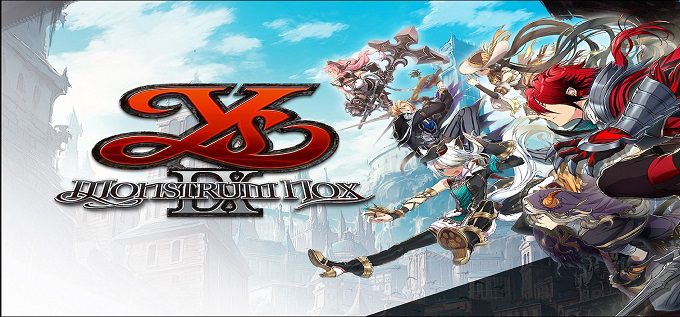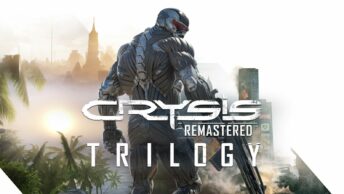Ys going for big changes in exploration!
Type: Single-player
Genre: RPG
Developer: Nihon Falcom
Publisher: NIS America
Console release: 05 Feb, 2021
Steam release: 06 July, 2021


Ys Balduq City
Reviewer’s Note: My only experience with Ys was Ys: Memories of Celceta (A colleague already did a review on it).
Ys is one of the longest-running series with slight but steady changes to the gameplay. With Ys: Memories of Celceta, a stable base and battle system seems to have been found that continues to date with small additions and changes.
Ys IX: Monstrous Nox continues the fast-paced battle system, but the developers decided to make a big change in regards to exploration. Instead of having the main character Adol traveling across a region. This time the game focuses on the fortress and prison city of Balduq. With the new abilities, it reminds you of the Batman: Arkham series by offering a vertical level design that wasn’t available before. This seems to be a complete departure from its predecessors.
Ys: Memories of Celceta convinced with good gameplay. However, it was relatively weak when it comes to the story. How much has it improved with Ys IX: Monstrous Nox?
The Story
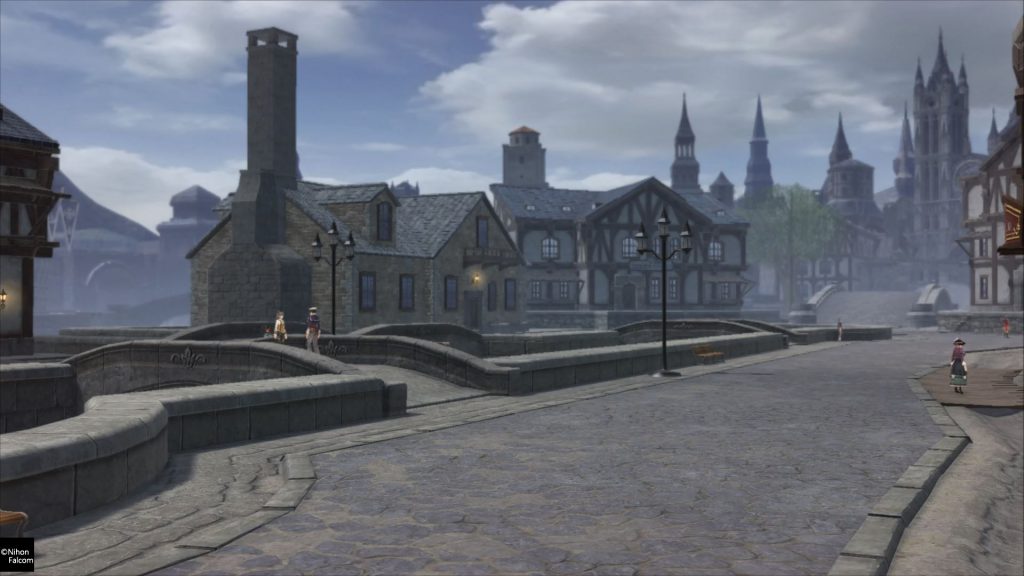
Adol’s mysterious adventure in the prison town of Balduq
The story starts with a surprise arrest at the gates of Balduq because Adol’s infamous reputation from his previous adventures has preceded him. After all, he is like a walking omen. Wherever he goes, trouble is sure to follow… or an adventure if it comes to Adol’s point of view.
This is followed by a whole series of events. First, he escapes from prison but is shot with a special bullet by the mysterious Aprillis and mutates into the Monstrum Crimson King. It comes with the special ability to teleport to certain points. The special abilities don’t come cheap as they come with restrictions and duties. The biggest one is that Balduq is a cage that the Monstrums can’t leave due to barriers preventing them. Then they have to fight in the Grimwald Nox, an alternative world in which the negative emotions manifest themselves as monsters called Lemures.
Since Adol obviously cannot leave Balduq, he is forced to prepare himself for a long stay. With the help of new allies, the new headquarters and tavern Dandelion (Dandelion) is created.
Many might despair at this situation, but for Adol Christin, it is just another exciting adventure and a mystery to be solved.
Who are the Monstrum? What is the Grimwald Nox? Why are people being imprisoned for no reason? What is going on with the prison? Many questions are gradually resolved in the course of the story.
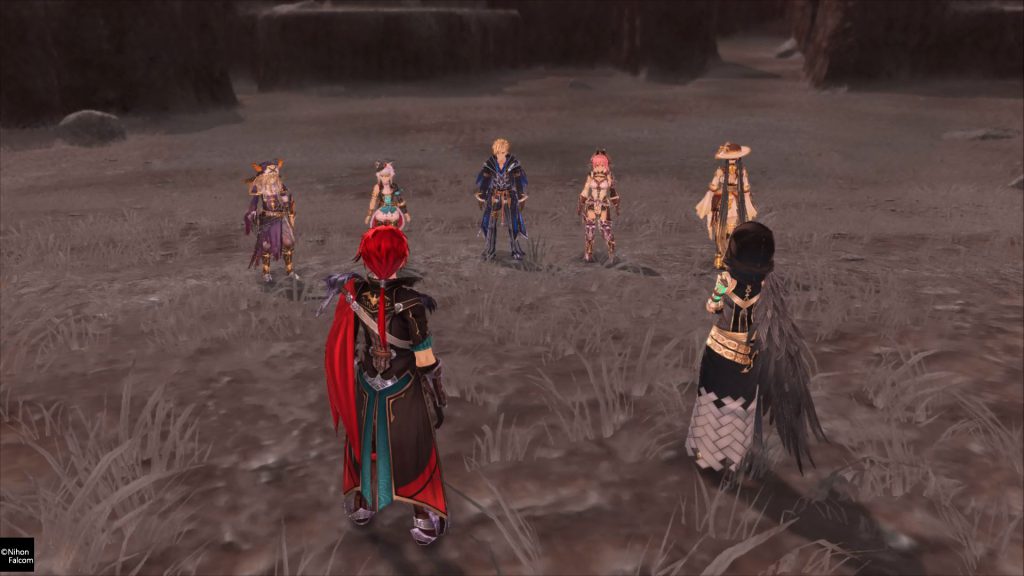
Story Impression
The story of Ys IX Monstrum Nox comes with many layers of mysteries that the players have to peel off one after another. Some are more obvious than others.
Each character gets their chapter to introduce themselves. You get to know their backgrounds and their problems, with the solution of the problems leading back to the prison and thus being part of the whole image.
The backstory of the city of Balduq also plays a big role and could be considered a character of its own.
Just like the Ys games before it, it is a self-contained story and can be played without prior knowledge. Along the way, past adventures are mentioned briefly with mentioned. It’s only a sentence or two, but it helps immensely to connect the stories.
Side missions consist of significant stories that add a lot to Balduq’s background. Likewise, through them, you come across new allies who linger in your headquarters and provide special services.
Grimwald Nox is perhaps the greatest mystery. Nevertheless, it also appears to be one of the greatest weaknesses in the story in terms of execution. There is no explanation why Adol has to dissolve individual barriers to districts when the other Monstrums don’t. It’s implied that they have already taken care of this problem for themselves individually. Likewise, the question remains open about the order of unlocking the barriers. They are small problems, but it does affect the believability a bit and they could have made something interesting out of it. Ironically, a character related to this also has a problem. A certain scene wasn’t built up enough to get a good emotional payoff from the player.
The antagonist has a particular spot in the story. You can tell that some things are going wrong in Balduq, but there are no clues as to who is behind it. Accordingly, you can say that the actual adversary is part of the puzzle. It’s an interesting dynamic since the protagonists don’t have an enemy as a goal. Instead, the goal is to solve all questions regarding Balduq.
Story-wise, Ys IX: Monstrum Nox relies on a compact story and thus manages to pull it off (apart from the aforementioned Grimwald Nox) neatly. There is no lack of surprises and the unknown gets the curiosity going.
The Gameplay
The combat system of Ys has already proven itself since Ys: Memories of Celceta, and with a few changes, it convinces once again that it wasn’t a fluke. This time, exploration is in the spotlight. With the decision to focus on the smaller region of the city of Balduq, it manages to offer something unique in the Ys series. Adol’s new repertoire in movement abilities called Gifts are allowing the players to experience the city in all three dimensions.
The review refers to the difficulty level Normal.
Controls
Due to the addition of the Gifts, more buttons are needed. Unfortunately, this results in several double assignments with one of them being rather inconvenient.
The dodge button also doubles as the run button. If you want to execute a faster jump, it often happens that you have to dodge once to activate the run. This is not so bad in the normal case, but as soon as it comes to platforming it can lead to a little complication. If you aren’t already holding down the run button, you have to press it and that leads to a dodge roll that could lead to you dodging into the abyss.
The next less critical overlap is the Flash Guard and Skill Modifier. Since both functions have been placed on the same button, you have to involuntarily perform a Flash Guard when using skills and results in a one to two-second cooldown. You can still evade in a time of need.
Other than that, the controls are easy to understand and shouldn’t be a problem. Camera-wise, it could be slightly confusing due to the aiming, but you quickly get used to it. In the options, the targeting can be limited to line of sight, as it usually even targets enemies through the walls.
Another good news is that the controls are customizable.
Exploration
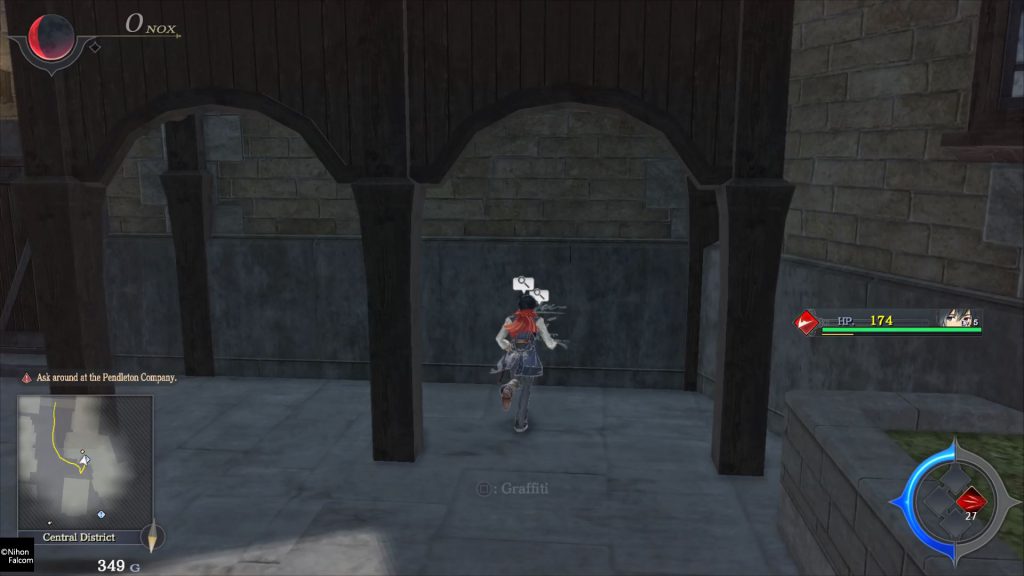
The city of Balduq is nothing more than a place for a scavenger hunt. The classic uncovering of the map and treasure chests are back. New items are landmarks (shown on the map), graffitis (shown on the map), and Azure Petals.
Each of the newly mentioned collectibles has an NPC who offers rewards as long as you reach a certain amount. Among the rewards are items that increase maximum SP.
Selected graffiti has the special function of awarding certain characters bonus status points. Azure Petals are the most difficult to find as they like to be placed on a higher elevation. Later you get the gift “Third Eye”, which makes the search a lot easier, as it allows you to look even through walls. There is a sign of higher mobility right from the start since the double jump is ready for use after the Monstrum transformation.
As already mentioned, barriers deny entry to parts of the city, which can only be unlocked via the story and forced Grimwald Nox.
Gifts
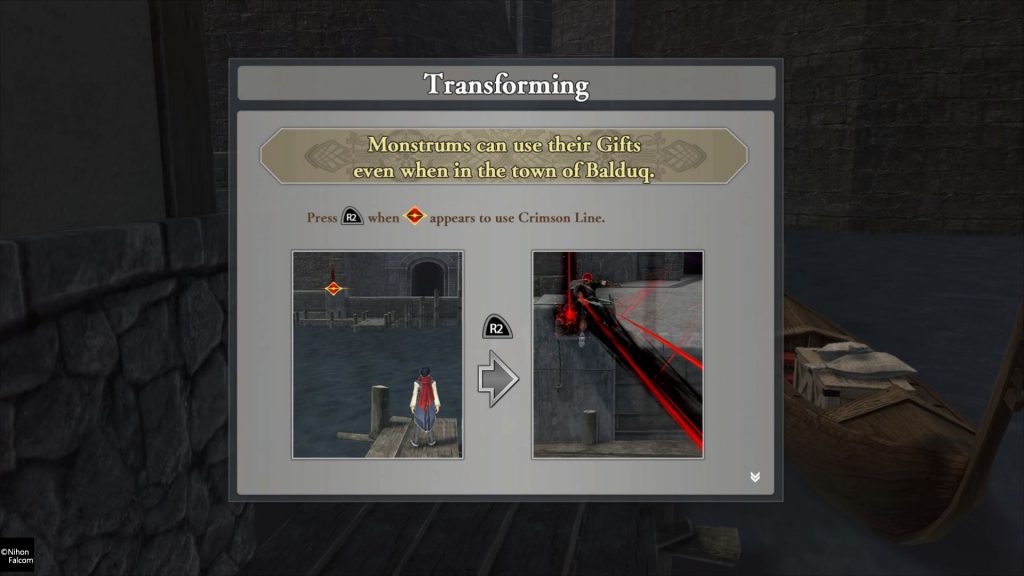
These abilities are the main event of Monstrum Nox and add depth to the exploration. For example, Heaven’s Run allows you to run up a wall, Hunter’s Descent lets the character glide in the air, and Crimson Line works like a grappling hook for select points.
Some also have a function for combat. Crimson Line lets you pull yourself to the targeted enemy.
The Gifts have a small limitation due to the Gift Gauge that can be seen below the character. It gets consumed upon usage and when not in use it recharges relatively quickly. When completely drained, there is a small penalty so that you can’t use the abilities again until the bar is full.
Grimwald Nox
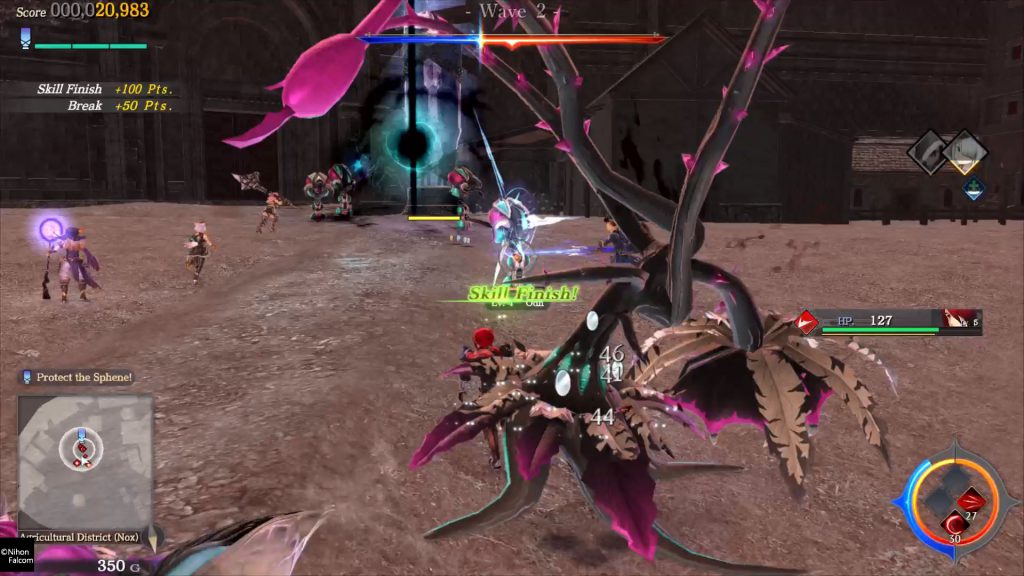
This is probably the most controversial part of the gameplay. It cannot be skipped and has optional missions. You can get into this battle arena in two ways: either via story or accumulating Nox to 100 (required for unlocking new or optional districts).
You get Nox either through voluntary fights in the city that award 3 or more points each, or side missions with a generous 20 or more. Once you reach 100 Nox, the entrance to the arena is unlocked to make a part of the city accessible.
The Grimwald Nox comes in two flavors Siege (Siege) and Purge (Purge):
Siege: Protect the crystal until all enemy waves have been dealt with. Many call it a type of tower defense.
Purge: There are Lacrimae crystals scattered around the arena that you have to destroy. Kill a certain amount and a boss appears. There are then two ways to finish the Purge. Either you defeat the boss or you destroy all the Lacrimae. The latter is recommended if the boss is too strong due to the time limit.
All Grimwald Nox have ratings and you get a reward corresponding rewards. On normal difficulty, I was always able to get the best rank (S).
If you don’t make it the first time, you can repeat the missions fairly early on.
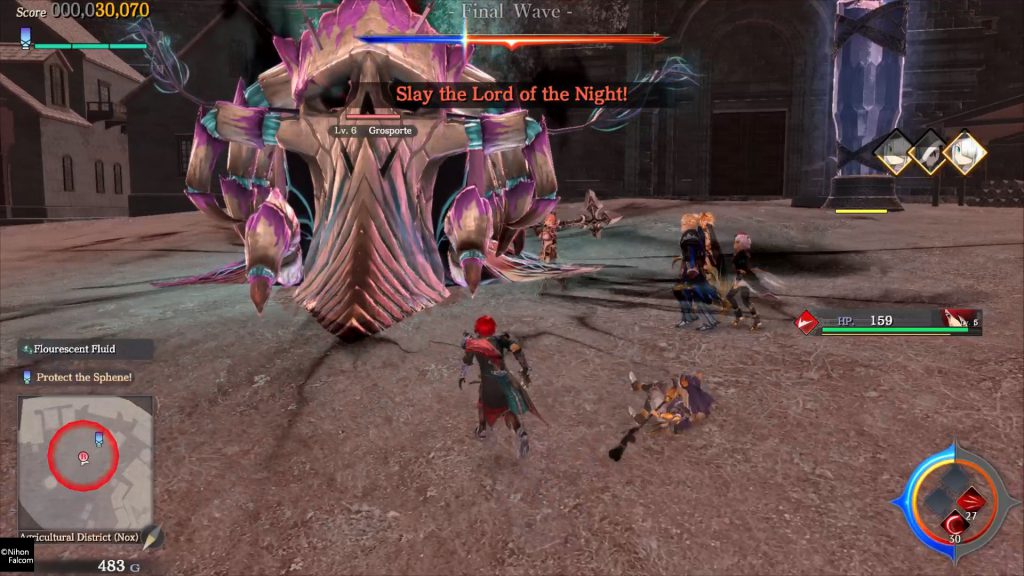
To make one’s life easier, fixed extra objects like lures and more become available as you progress through the story. You can create and upgrade them at the cost of materials. On another note, it’s the only situation where all 6 characters fight together.
The problem with Grimwald Nox is that it feels too much like a filler to extend the game time. While the use of 6 characters is a nice idea, it doesn’t take into account the strengths of the gameplay enough because it doesn’t offer an answer to the question “How can I make the fighting temporarily even more fun?”.
All excess Nox at the end of a chapter are converted to Twilight Shards and can be exchanged for objects. Towards the end, you can activate the process manually.
Health Points and Healing Plates
Just like its predecessor, health recharges automatically when standing outside a dungeon. A piece of special equipment called Sacramentals is required to utilize the recovery within a dungeon. However, you get it pretty early on. This type of healing doesn’t get much use on normal difficulty if you’re confident in your fighting capabilities, but it is a good option for saving consumables.
Healing plates are spread all over Balduq at important places. In dungeons, they are always a sign of an upcoming boss fight. The plates have the additional function of fast travel points.
Consumables
There are two types of healing items: normal items and potions. Potions are similar to those in Zelda because you need empty bottles to brew them. They are mainly strong because they recover HP on a percentage basis that means they are always effective regardless of your level. The material for brewing is the biggest cost issue.
Food can be cooked at headquarters and provide special temporary effects. One for example is infinite SP.
The oddest items are the elixirs that permanently increase your stats, which are probably part of the postgame. It’s not often you see an RPG generously offering strength and defense elixirs as long as you have the money, and that’s the case here.
Quality of Life things
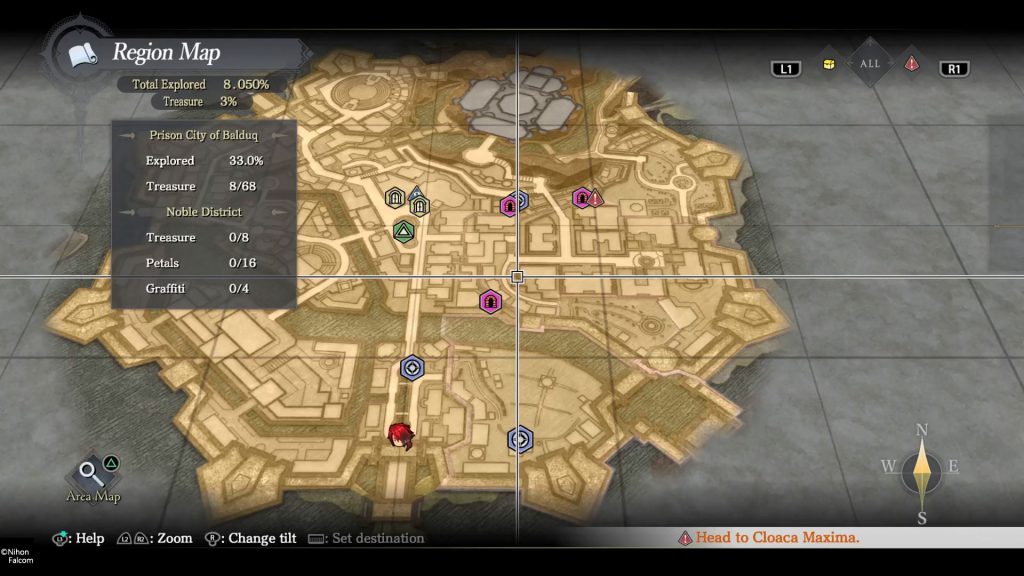
Just like Trails of Cold Steel, Ys IX offers generous fast travel that cuts down on unnecessarily traveling time. The map provides a ton of warp points and shows pretty much all collectibles except Azure Petals.
Furthermore, there are side missions that are more about avoiding traps, including some that cause instant death. Got an issue with these side missions? When you die, you can choose to skip it.
Combat
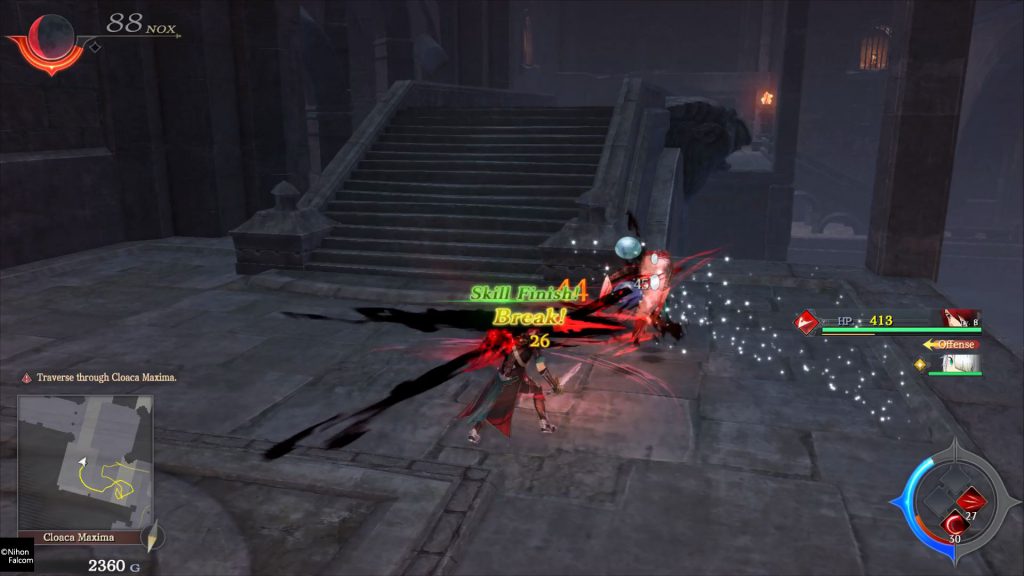
The combat system got slight changes. The fights are still fast-paced, allow for the constant use of skills, and maybe even more fast-paced than before. The decision was made to set as few limits as possible for the player. This has a very positive effect on the combat system. The normal attacks are there to deal constant damage filling the idle time between skills as SP gauge recharges.
Since the characters are strong in offense and defense, they fall under the concept of the glass cannon. This means that they are not designed to take many hits. Normal enemies don’t pose much of a threat individually, but damage can accumulate if you’re not careful. The bosses, on the other hand, are more powerful and can knock out a character with just a few attacks.
Team, attack types and AI
Up to 3 characters can be in the active team. As always, each one has one of three fixed attack types and there is a bonus for specific compositions. Put the team together with three attack types and the drop rates increase. If there are two with the same type you get an attack buff. With 6 Monstrums, you have two characters to choose from for each attack type.
Surprisingly, the AI seems to be much better than in Ys: Memories of Celceta. Unlike many other games, the AI acts as a satellite and augments the player’s actions. This means they only attack when the player attacks and use skills at no extra cost. In exchange, they are extremely capable of dodging. So if you’re afraid that the AI will sloppily die off while you’re fighting for your life, fear not as it’s unlikely to happen (at least on normal) as it did on my playthrough.
Attack bonuses
They play a somewhat minor role with 2 types. Air combo and skill knockout. The air combo is surprisingly hard to use as I couldn’t find an attack that would get the opponent airborne. The most common bonus is the skill K.o., which recovers about half of the SP used in the killing hit.
Break and Stun
The opponents have two special states that can be triggered by attacks. Break nullifies the defense. Stun goes a bit further and renders them helpless for a short time. The latter is especially important in boss fights because that’s when the most damage is dealt.
Skills
Skills are above average abilities that consume SP to lay down the hurt or manipulate the enemies in a certain way. The stronger the skill, the higher the consumption. The initial maximum charge is 100 and can be increased with special items. New skills appear automatically when fighting and can be used in one of the skill slots from that point on. Each skill has a maximum level of 3 that can be reached with constant use and sometimes come with additional effects. It’s important to keep their utility in mind as these special moves tend to have a different range, etc.
All are rated in 3 different categories:
Power (strength): Indicates the amount of damage.
Break (defensive break): Shows the damage that puts the opponent in the break state.
Stun: Shows the amount of stun damage.
Advanced Techniques
Flash Guard and Flash Move are back to offer an even more player activity. Flash Guard can be used at almost any time. Successfully guard an attack and it will provide invulnerability and guaranteed critical hits for a short time.
Flash Move is activated in much the same way as Flash Guard but by dodging just before the hit. As a bonus, it also gives invulnerability and slows down the environment (i.e. Bullet Time). Dodging only has a very period of invulnerability but it’s fast and has no cooldown so it’s a powerful defensive tool.
The reason for both of these powerful defense techniques is that the player can attack without worry and respond to attacks at almost any time. The risk hinges on the timing. Do a mistake and you’ll get hit in the worst case.
It is possible to activate both, but you have to be careful not to accidentally activate Boost Mode. Dodge first and then activate Flash Guard since this input sequence does not activate the Boosting.
Boost and EXTRA Skill(R1+L1)
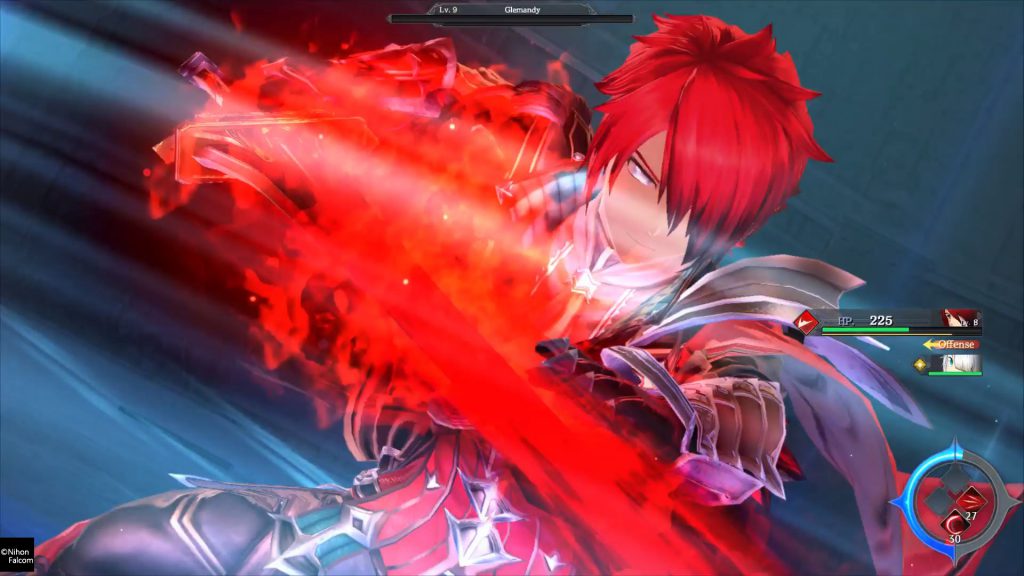
Almost all successful maneuvers charge the boost bar. Boost Mode is available at 50%, which is another piece of the puzzle that contributes to the fast pace of the combat system. In Boost Mode, the life of all 3 characters is steadily regenerated by percentage. It also offers stat buffs and the powerful attack EXTRA skill becomes available. The latter fully depletes the Boost Gauge.
Attacks and skills accelerate the consumption of the boost. Defeating enemies is the only thing that rebuilds the bar while you’re in Boost state. The gauge lasts for a short time after the fight and reduces completely to zero if no further successful attacks occur.
Confident fighters can fight through enemy masses without using healing items or standing still for HP recovery due to Boost. It’s a big game-changer when it comes to the pace of the game.
Boss Battles
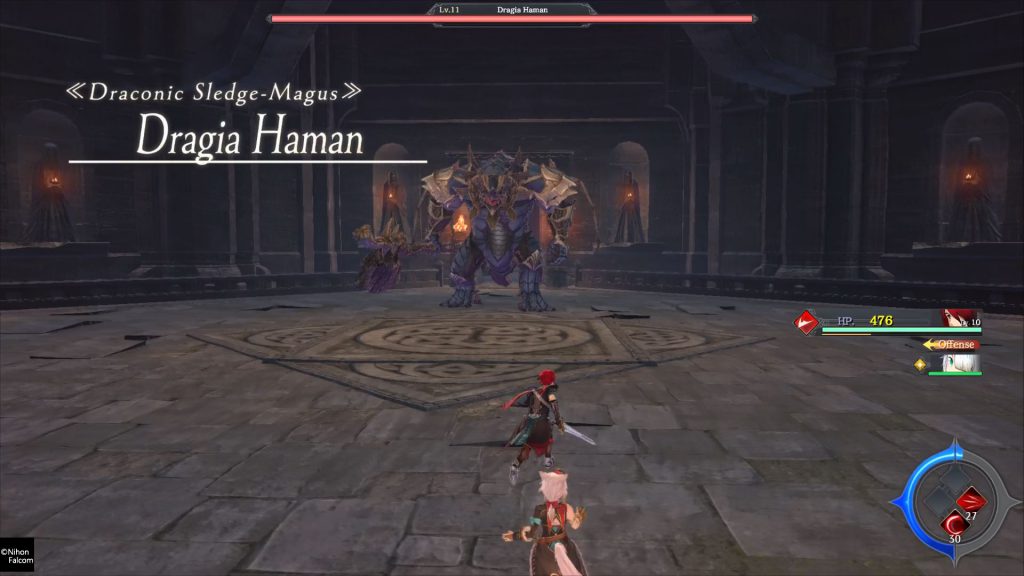
Bosses are, as always, stronger opponents where you fight carefully while slowly figuring out their attack plan. New in Ys IX is the use of the gift Third-Eye to find out the weak point of the boss.
As always, it should be possible to defeat all enemies without taking a hit. At no point could I find anything frustrating about these fights so they are well balanced, at least on normal.
Equipment and status changes
Let’s get to the last big point. Many of the customization options present in Ys: Memories of Celceta are no longer here. Instead, you can upgrade each weapon up to twice. Armors have no customization. This could be a balancing and pacing decision, as the combat capabilities are rather high.
For status changes to be used, accessories must now be equipped, which consumes one of two slots. Surprisingly, there are only a handful of status abnormalities even though there was much more before. If I had to take a guess, it should be at least halved.
At first, you might think that these changes are questionable but when you look at the full picture you can see that they removed the excess and made the combat much leaner and faster-paced.
Gold
The question of how money works often comes up in RPGs. Ys IX opts to be on the moderate side here, i.e. after the dungeon, you have enough to equip at least 3 characters with new weapons and armor. As long as you finish off all the enemies along the way and collect the money. You can find additional stacks of cash in chests that offer an additional buffer.
Sacramentals
These are special pieces of equipment that give a passive bonus. For example, HP recovery by standing still in the dungeon, a greater range for collecting loot, halved consumption of the EXTRA skill, etc. You only get one slot in the beginning and those can be expanded by finding special items.
These extra skills provide an enhancement to the player experience to the point where I have to question whether this was a good decision. Maybe it would have been better if they made them a permanent buff instead.
Game length and New Game+
A playthrough on Normal took me about 30 hours, completing all side missions, optional Grimwald Nox, and finding all graffiti and landmarks. As for the Azure Petals, I was missing a single one.
In New Game+, bonuses can be set at launch and should be of interest, especially for the extremely high difficulty levels.
Gameplay Impression
Ys IX: Monstrous Nox is very different from its predecessors. The lack of a large landmass comes with its advantages and disadvantages. The latter is strongly reflected in the visuals in terms of variety.
The collectibles and discovery aspect has been executed very well. Although it sounds like a lot, the game manages to keep the frustration to an extreme minimum, since many design decisions help the player out.
Another point is the reduction of customizations and status changes. At first glance, it seems like a point of criticism, but in exchange, the time spent on the menus is greatly reduced. This shows that there’s more emphasis on the game’s pacing and less on micromanagement.
The battles are fast-paced and consist of constant attacking with an active defense. Having SP recharge passively is a fantastic decision and helps keep the fun factor high.
Speaking of pacing, as mentioned earlier Grimwald Nox is the strangest part of the game. These particular battles are most likely meant to add some variety to the flow of the game. Siege is a tower defense without any real customization options and is more like a horde mode. While Purge is like a small scavenger hunt with a time limit. Whether you like it or not is up to you.
The last big plus point is the Quality of Life decisions that make life easier for the player. It’s thanks to this that it’s a smooth sailing experience.
Graphics and Sound
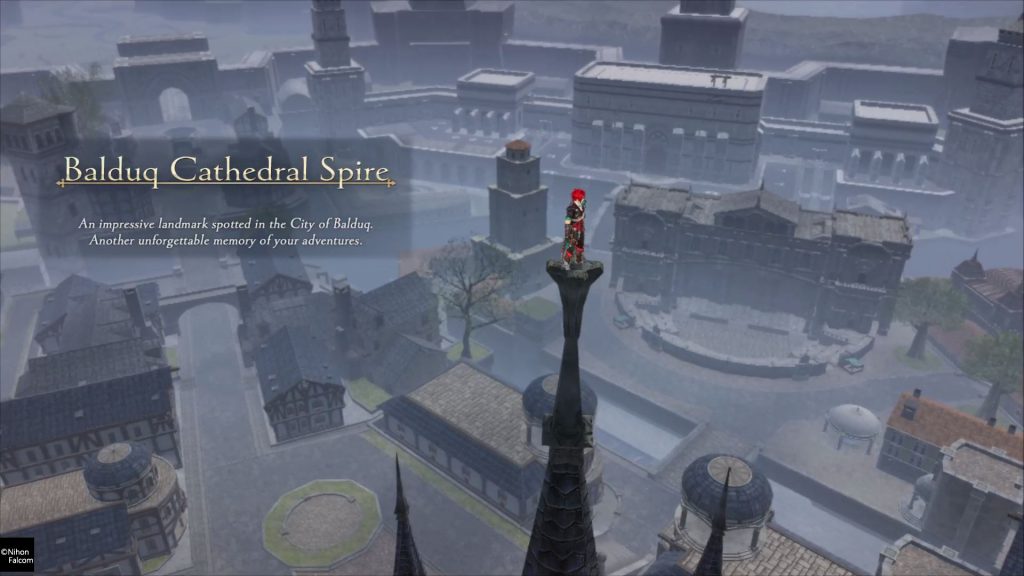
Visually, the game is on the moderate side. The advantage here is that the game is only about 8 GB in size and the loading times are rather short. The latter is especially important during fast travel.
The city of Balduq is reminiscent of a medieval fortress city with several districts. There are of course great challenges in visual design due to the game being restricted to this place. Fortunately, each district has features that make them stand out. For example, the Entertainment District has a coliseum, while the Noble District features the architecture of apartment buildings with walls not found anywhere else.
Apart from the design, the color palettes are unfortunately more towards gray and brown. Most environments are made of stone with a few excursions into the greenery.
In the predecessors, you were always happy to find new cities, as they differed visually in culture. The omission here leads to a lack of variety. If I had to give this game a description it would be lean and mean because you’re always moving around with a purpose without wasting time going into people’s houses.
A big plus is the many different enemies. There’s no recycling of enemy models.
The main characters are the most detailed part of the game with their special designs in normal and Monstrum form. You can recognize the facial expressions and emotions in cutscenes, which helps to add to the atmosphere.
The music is very good and is reminiscent of a music style from the PS2 era, a simpler time. Many areas have their music and the city of Balduq even has several for each situation. There’s one exception though. In one particular dungeon, the tone of the music track is too uneven, as it is more in the quiet range until the electric guitar kicks in for a short time and disrupts the flow. I would say this was also one of the problems with Dragon Quest XI and its travel music piece.
The characters are voiced in Japanese or English for important scenes and there’s nothing to criticize.
Verdict
Ys IX: Monstrous Nox is a surprising step in a different direction and a continuation of the successful battle system. The brand new mechanics give the player the freedom to explore the city of Balduq from top to bottom and do so successfully. While it’s not without its drawbacks, like only being able to linger in Balduq or Grimwald Nox’s implementation feeling off.
It has also become leaner with customizations and status changes being limited to a handful of options. Leading to a much faster-paced game. Comparable to a steady sprint with short narrative breaks. It knows what it wants to do and does it with excellence 95% of the time.
Overall, Ys IX: Monstrum Nox does not appear to be a straightforward evolution of its gameplay, but a side step. Action RPG fans of fast-paced gameplay should find just the right thing here. Ys IX: Monstrum Nox is just like Ys: Memories of Celceta a clear recommendation, maybe even moreso.

